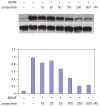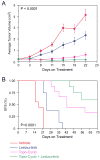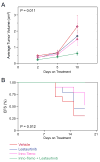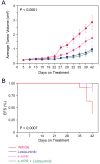Lestaurtinib enhances the antitumor efficacy of chemotherapy in murine xenograft models of neuroblastoma
- PMID: 20179224
- PMCID: PMC2831131
- DOI: 10.1158/1078-0432.CCR-09-1531
Lestaurtinib enhances the antitumor efficacy of chemotherapy in murine xenograft models of neuroblastoma
Abstract
Purpose: Neuroblastoma, a common pediatric tumor of the sympathetic nervous system, is characterized by clinical heterogeneity. The Trk family neurotrophin receptors play an important role in this behavior. Expression of TrkA is associated with favorable clinical features and outcome, whereas TrkB expression is associated with an unfavorable prognosis. We wanted to determine if the Trk-selective inhibitor lestaurtinib had therapeutic efficacy in a preclinical neuroblastoma model.
Experimental design: We performed intervention trials of lestaurtinib alone or in combination with other agents in TrkB-overexpressing neuroblastoma xenograft models.
Results: Lestaurtinib alone significantly inhibited tumor growth compared to vehicle-treated animals [P = 0.0004 for tumor size and P = 0.011 for event-free survival (EFS)]. Lestaurtinib also enhanced the antitumor efficacy of the combinations of topotecan plus cyclophosphamide (P < 0.0001 for size and P < 0.0001 for EFS) or irinotecan plus temozolomide (P = 0.011 for size and P = 0.012 for EFS). There was no additive benefit of combining either 13-cis-retinoic acid or fenretinide with lestaurtinib compared to lestaurtinib alone. There was dramatic growth inhibition combining lestaurtinib with bevacizumab (P < 0.0001), but this combination had substantial systemic toxicity.
Conclusions: We show that lestaurtinib can inhibit the growth of neuroblastoma both in vitro and in vivo and can substantially enhance the efficacy of conventional chemotherapy, presumably by inhibition of the Trk/brain-derived neurotrophic factor autocrine survival pathway. It may also enhance the efficacy of selected biological agents, but further testing is required to rule out unanticipated toxicities. Our data support the incorporation of Trk inhibitors, such as lestaurtinib, in clinical trials of neuroblastoma or other tumors relying on Trk signaling pathways for survival.
Figures





Similar articles
-
Entrectinib is a potent inhibitor of Trk-driven neuroblastomas in a xenograft mouse model.Cancer Lett. 2016 Mar 28;372(2):179-86. doi: 10.1016/j.canlet.2016.01.018. Epub 2016 Jan 18. Cancer Lett. 2016. PMID: 26797418 Free PMC article.
-
AZ64 inhibits TrkB and enhances the efficacy of chemotherapy and local radiation in neuroblastoma xenografts.Cancer Chemother Pharmacol. 2012 Sep;70(3):477-86. doi: 10.1007/s00280-012-1879-x. Epub 2012 May 24. Cancer Chemother Pharmacol. 2012. PMID: 22623209 Free PMC article.
-
TrkB inhibition by GNF-4256 slows growth and enhances chemotherapeutic efficacy in neuroblastoma xenografts.Cancer Chemother Pharmacol. 2015 Jan;75(1):131-41. doi: 10.1007/s00280-014-2627-1. Epub 2014 Nov 14. Cancer Chemother Pharmacol. 2015. PMID: 25394774 Free PMC article.
-
Temozolomide in combination with other cytotoxic agents.Semin Oncol. 2001 Aug;28(4 Suppl 13):24-33. doi: 10.1016/s0093-7754(01)90068-5. Semin Oncol. 2001. PMID: 11550136 Review.
-
Trk receptor expression and inhibition in neuroblastomas.Clin Cancer Res. 2009 May 15;15(10):3244-50. doi: 10.1158/1078-0432.CCR-08-1815. Epub 2009 May 5. Clin Cancer Res. 2009. PMID: 19417027 Free PMC article. Review.
Cited by
-
Protein Kinase N1 control of androgen-responsive serum response factor action provides rationale for novel prostate cancer treatment strategy.Oncogene. 2019 Jun;38(23):4496-4511. doi: 10.1038/s41388-019-0732-7. Epub 2019 Feb 11. Oncogene. 2019. PMID: 30742064 Free PMC article.
-
Entrectinib is a potent inhibitor of Trk-driven neuroblastomas in a xenograft mouse model.Cancer Lett. 2016 Mar 28;372(2):179-86. doi: 10.1016/j.canlet.2016.01.018. Epub 2016 Jan 18. Cancer Lett. 2016. PMID: 26797418 Free PMC article.
-
AZ64 inhibits TrkB and enhances the efficacy of chemotherapy and local radiation in neuroblastoma xenografts.Cancer Chemother Pharmacol. 2012 Sep;70(3):477-86. doi: 10.1007/s00280-012-1879-x. Epub 2012 May 24. Cancer Chemother Pharmacol. 2012. PMID: 22623209 Free PMC article.
-
Targeting the BDNF/TrkB pathway for the treatment of tumors.Oncol Lett. 2019 Feb;17(2):2031-2039. doi: 10.3892/ol.2018.9854. Epub 2018 Dec 20. Oncol Lett. 2019. PMID: 30675270 Free PMC article. Review.
-
Combination therapy with gefitinib and doxorubicin inhibits tumor growth in transgenic mice with adrenal neuroblastoma.Cancer Med. 2013 Jun;2(3):286-95. doi: 10.1002/cam4.76. Epub 2013 Apr 2. Cancer Med. 2013. PMID: 23930205 Free PMC article.
References
-
- Kaplan DR, Martin-Zanca D, Parada LF. Tyrosine phosphorylation and tyrosine kinase activity of the trk proto-oncogene product induced by NGF. Nature. 1991;350:158–60. - PubMed
-
- Squinto SP, Stitt TN, Aldrich TH, et al. trkB encodes a functional receptor for brain-derived neurotrophic factor and neurotrophin-3 but not nerve growth factor. Cell. 1991;65:885–93. - PubMed
-
- Lamballe F, Klein R, Barbacid M. trkC, a new member of the trk family of tyrosine protein kinases, is a receptor for neurotrophin-3. Cell. 1991;66:967–79. - PubMed
-
- George RE, Li S, Medeiros-Nancarrow C, et al. High-risk neuroblastoma treated with tandem autologous peripheral-blood stem cell-supported transplantation: long-term survival update. J Clin Oncol. 2006;24:2891–6. - PubMed
Publication types
MeSH terms
Substances
Grants and funding
LinkOut - more resources
Full Text Sources
Other Literature Sources
Medical

